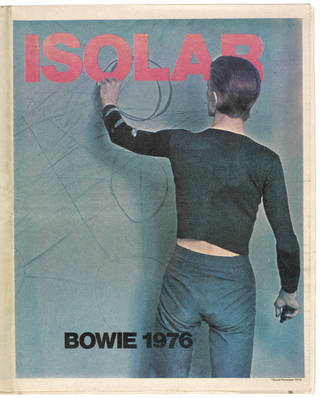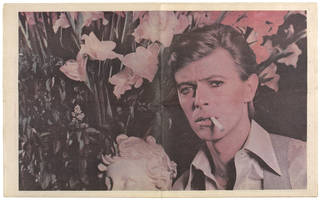David Bowie (1947 – 2016) is widely regarded as a musical innovator and cultural icon. His career spanned five decades and had a major influence on the contemporary arts.
A chameleonic figure, Bowie periodically reinvented himself, creating on-stage personas such as Ziggy Stardust and the Thin White Duke. The visual potency of this shifting identity, which helped cement Bowie’s reputation as an innovative and uncompromising artist, is vividly conveyed within the V&A’s collection of Bowie images and memorabilia.
An early example of Bowie’s visual theatricality is the cover of his third album, The Man Who Sold the World, released in April 1971. The cover image, photographed by Keith McMillan, presents a deliberately provocative and androgynous image, with Bowie wearing a ‘man-dress’ by pioneering 1960s designer Mr Fish. The cover was considered too controversial for the American market and replaced with a cartoon image of a cowboy carrying a gun. Nonetheless, Bowie wore such a man-dress on his first tour to the USA, provoking a range of strong reactions.

Perhaps one of Bowie’s most enduring looks is embodied in the Aladdin Sane album sleeve, devised by Pierre Laroche. Aladdin Sane was the first album Bowie wrote and released from a position of stardom, while cultivating his Ziggy Stardust alter ego. The cropped hairstyle and flash of red and blue facial make-up was imitated by fans attending his concerts, who used the album sleeve as a model. It remains as one of the ultimate Bowie signifiers, adopted across social media profiles by fans after his death in 2016.

During the 1973 Aladdin Sane tour, Bowie was photographed by music photographer, Kevin Cummins. Cummins went onto photograph Bowie throughout his career and the pair formed a close working relationship. The V&A acquired one of Cummin’s classic David Bowie photographs: a bold black and white image which captures the on-stage drama of Ziggy Stardust – the pose, the hairstyle and the flamboyant jumpsuit – yet still conveys a sense of truthful intimacy.

In the mid 1970s, Bowie rejected Ziggy and adopted the paired down persona of the Thin White Duke. He recorded several studio albums and toured in 1976 and 1978. The V&A have two rare newsprint programmes from these tours, Isolar (also known as the Thin White Duke tour or the Station to Station tour) and Isolar II (also known as the Low/Heroes tour). Bowie designed the programmes himself, in the style of interfold newspapers. Although they are only two years apart, they represent two distinct periods of Bowie’s life and career.

The Isolar programme features photographs taken during the recording of the Station to Station album, as well as images from the filming of Nic Roeg's cult science-fiction film, The Man Who Fell To Earth, in which Bowie acted. The programme conveys a distinct starkness, in keeping with Bowie’s Thin White Duke persona, who was a darker character, associated with a period of heavy drug use.

The Isolar II programme features photographs that were taken while Bowie was recording his albums Low and Heroes with Brian Eno. By this time, Bowie had become resident in Berlin, having moved there to escape the drug scene in Los Angeles and to retire the controversial Thin White Duke. Low and Heroes, along with Bowie’s 1979 album, Lodger, have since become known as The Berlin Trilogy, recognised for their innovative electronic/ambient sound.

In 1983, Bowie undertook his longest, largest and most successful concert tour, the Serious Moonlight Tour, designed to support his latest album, Let’s Dance. On this tour, Bowie shelved the flamboyance of Ziggy Stardust, the hollow cool of the Thin White Duke, and the arthouse austerity of the Berlin era, reinventing once again as a smooth-suited purveyor of cosmopolitan pop. Our collections include several Serious Moonlight tour merchandise items, featuring artwork by acclaimed designer/illustrator, Mick Haggerty, which perfectly captures this slick new era.



